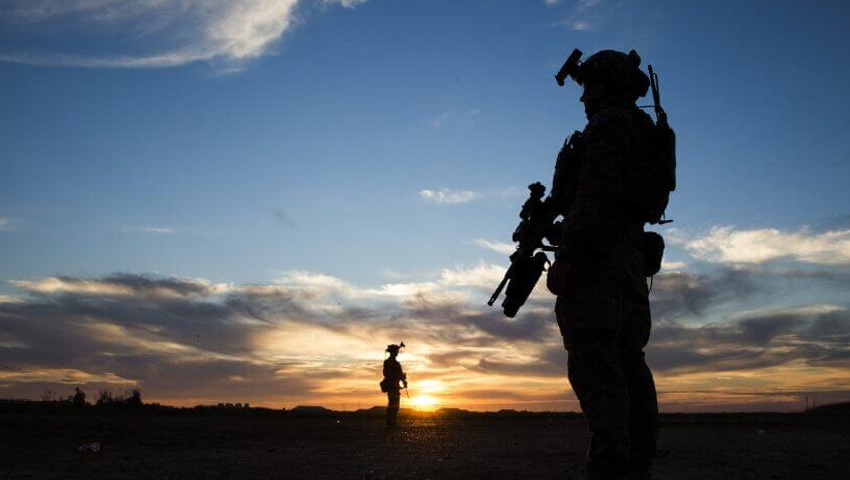With a small population and no national security strategy, what happens if Australia loses the next war? It’s time to put an insurgency back on the cards, because insurgency is a tactic not a swear word.
The penetration of electronic, cyber, information and space warfare into conventional warfighting apparatuses must serve as a shake-up to Australia’s traditional land warfare practices. For example: covert ground-based operations are no longer covert with thermal and radar imaging, and even APCs provide little protection against UAV guided munitions. Land-based fighting must change to adapt to the future.
This is a challenge that will have to be overcome by modern military leaders when preparing for the next conventional war. We all remember the maxim, “you go to war with the army you have, not the army you might want or wish to have at a later time,” but it seems obvious that if the army you have is still digging in while the enemy flies armed-UAVs overhead, there’s going to be a problem.
So, what’s the missing ingredient? Just perhaps, in the face of robotics and autonomous systems, the best use of ground fighting units isn’t proactively on the front lines but making Australia’s population centres ungovernable on the homeland.
Under the Biden administration, the United States confirmed that it would continue the Trump policy of withdrawing troops from Afghanistan, marking an end to 20-years of US occupation in the country. Despite thousands of deaths, the coalition remained unable to defeat the Taliban or even ensure that Taliban fighters won’t seize power once the United States leaves.
Likewise, Hezbollah in southern Lebanon, Sunni and Shi’ite insurgencies in Iraq, Houthi rebels in Yemen – these are just a few modern examples of successful asymmetric warfighting forces. Before this, the Viet Cong in Vietnam and even guerrilla operations in revolutionary France have stood out in history for their efficacy as fighters.
The key lesson from this is that technology might win the conventional war, but it doesn’t decide who wins once conventional fighting is over. As such, Australia must start thinking about what comes after conventional war. The US Department of Defense has already confirmed that the United States is in their weakest military position since the Cold War. As with the inability for Britain to control the Pacific after the fall of Singapore in World War II, Australia can no longer rely on the ability for the US to be a deterrent.
Without any kind of nuclear weapon or a strong offensive cyber capacity, what is Australia’s deterrent if it’s not the United States? None.
Simply, Australia needs to have a back-up plan for what happens when war goes wrong. Australia needs to become ungovernable. A long-term insurgency against an invading force which is already stretched thin to cover Australia’s huge landmass may prove to be a guarantor of Australian sovereignty.
One of the best examples of this can be found in Chairman Mao’s teaching on insurgency. Written in 1937 after the Japanese invasion of mainland China and with the backdrop of anti-colonial guerrilla wars across the developing world, Mao’s ‘On Guerrilla Warfare’ provides an erudite lesson on conducting guerrilla warfare. Using both Chinese and foreign examples to teach the reader how to conduct, organise and wage their own guerrilla war against a foreign invading force, the book should be compulsory reading for all military decision makers.
Specifically, Mao writes: “alertness, mobility, and attack. It must be adjusted to the enemy[’s] situation, the terrain, the existing lines of communication, the relative strengths, the weather and the situation of the people.
In guerrilla warfare, select the tactic of seeming to come from the east and attacking from the west; avoid the solid, attack the hollow; attack; withdraw; deliver a lightening blow, seek a lightening decision. When guerrillas engage a stronger enemy, they withdraw when he advances, harass him when he strops; strike him when he is weary; pursue him when he withdraws.”
In the Middle East, few groups have refined the craft of insurgency like Hezbollah. Indeed, according to the Jerusalem Post, the IDF calls Hezbollah “the disappearing enemy” due to their ability to hide among civilians and disappear into complex tunnel and bunker networks. This prompted the creation of a new “expose and destroy” company within the IDF which draws on expertise from members from the armoured, artillery and specialist air force divisions to seek, locate and destroy their enemy.
No wonder Hezbollah is considered the disappearing enemy.
As Exum wrote in the Washington Institute for Near East Policy in 2006, “and if the battle indeed went against them, the fighters could just go back to being ‘civilians’ with no Hizballah uniforms or unit patches to inform the IDF of their dual identity.”
“Because Hezbollah was entrenched in friendly Shiite-inhabited villages and underground bunkers constructed in secret over several years, a withering Israeli air campaign and a tank-led ground assault were unable to establish full control over a border strip and sweep it clear of Hezbollah guerrillas,” Cody and Moore wrote for the Washington Post in 2006.
Indeed, this home ground advantage removes much of the logistical and communications burdens felt when trying to co-ordinate and support conventional fighting forces.
Australia must consider what happens after the war. As a nation, we have a small population with lots of country to cover. Our key decision makers might find that insurgency isn’t a scary concept confined to the developing world, but a legitimate military tactic which will serve as a deterrent to any enemy looking to land in Australia. Thus, guerrilla warfare and insurgency must be a core teaching module in our defence forces.
Get involved with the discussion and let us know your thoughts on Australia's future role and position in the Indo-Pacific region and what you would like to see from Australia's political leaders in terms of partisan and bipartisan agenda setting in the comments section below, or get in touch with


